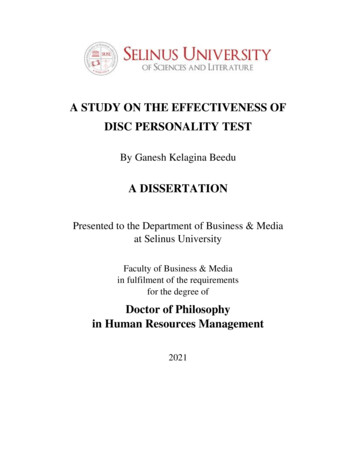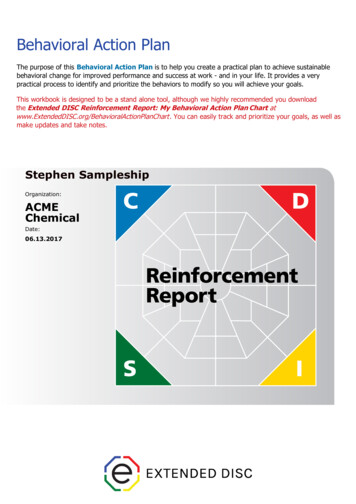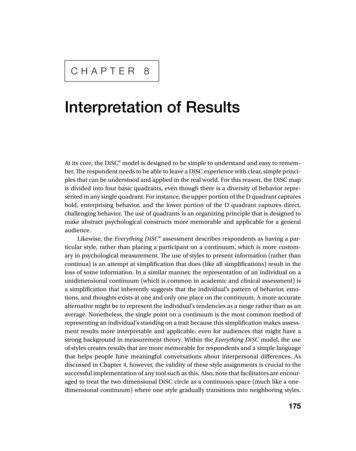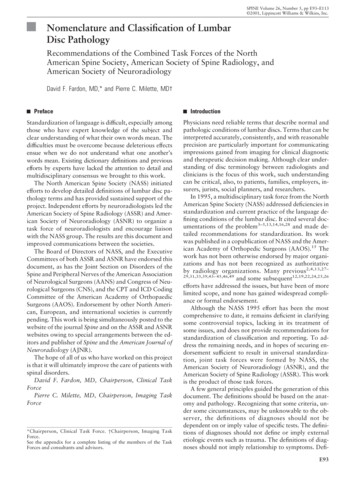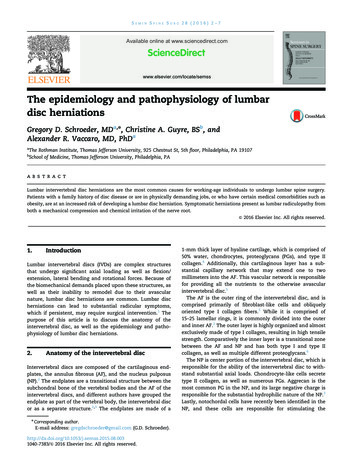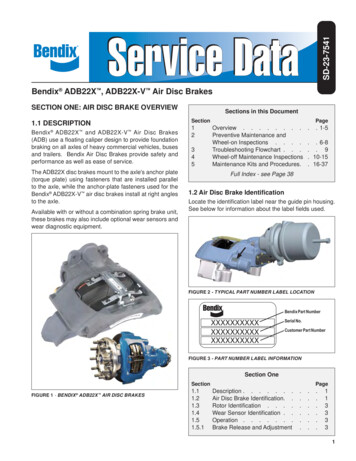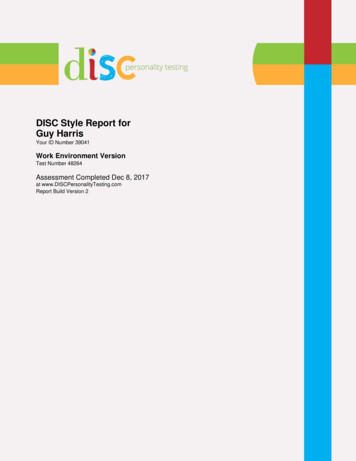
Transcription
DISC Style Report forGuy HarrisYour ID Number 39041Work Environment VersionTest Number 48264Assessment Completed Dec 8, 2017at www.DISCPersonalityTesting.comReport Build Version 2
Guy,How to Get the Most from Your Assessment Look at your graphs (page 3). Read the style descriptive pages (pages 4-12). Reflect on what the report tells you – make notes in it, underline key points, andthink about how you can use what you have learned to develop better skills forconnecting and communicating with others. Read the information about the DISC model for greater insights into both thestrengths and limitations of the model (pages 13-28). Share your results and discuss them with someone you trust to give you honestfeedback. For expert, objective feedback and advice about using this information,schedule a conversation with one of our professional DISC coaches. Learn moreabout this opportunity at http://DISCPersonalityTesting.com/coaching .Reading Your GraphsThe Bar GraphsWhen we look at your graphs to identify your predominant traits, we focus on theNatural or Internal style graph (specifically the bar graphon the left side of page 3). We do this because yourNatural style tends to be more consistent and lessinfluenced by what you were thinking about at the timeyou took the assessment.We use yourNatural (Internal)style graph todevelop this report.Does this focus mean that your Adapted stylegraph is unimportant?Absolutely not!Copyright 2017, All Rights Reserved, www.discpersonalitytesting.comGuy Harris - ID 39041 - Test Number 48264 - Page 1
You can learn a great deal by comparing your Natural style graph with yourAdapted style graph to find both similarities and differences. Careful examination of thetwo bar graphs can give you a great deal of valuable information and insights into how(and possibly why) you act the way you do and great clues about how you can betteradapt your behaviors to connect and communicate with others more effectively. In anutshell, one is more internal – related to your drives and motivations – and the other ismore external – related to the actual behaviors you show to others. Here’s what the twocharts tell you: You Natural style generally represents the perspectives, viewpoints, orfilters you use to view and interpret the world. It also probably describesthe type of environment that would be most comfortable for you. Your Adapted style usually describes the set of behaviors you havelearned to use to adapt to the environment where you live and work.If you would like expert assistance and insights on how to better interpret thesimilarities and differences between your two bar graphs, we suggest that you speakwith a DISC coach who has studied the model in depth and can guide you through theinterpretation process.The Pie ChartsThe pie charts add additional insights and highlight the fact that your style is ablend of all four styles. Because of this blending of traits,you are not exactly like any other person – not even aperson with a very similar blend. This report will give youinsights based on how your traits fit within the overallYour style is a blendof all four DISCstyles.spectrum of trait blends. Read it, reflect on it, mark it up witha pen or pencil if necessary. Use the report as a starting-point for discussion andreflection. Take what it says and make it personal to you. Then you will have a great toolfor improving your effectiveness at working, communicating, and connecting with otherpeople.Copyright 2017, All Rights Reserved, www.discpersonalitytesting.comGuy Harris - ID 39041 - Test Number 48264 - Page 2
Congratulations Guy!Your style is C/SDYour Natural / Internal StyleYour Adapted / External StyleThe bar graphs below show the intensity or consistency of each style in your blend.The pie charts below show the relative mix of each style in your blend. The data is rounded andmight not equal exactly 100%.Your natural, or internal, style represents theinternal motivations that drive you the most. Thisis the part of you that is likely to represent howyou think or feel about situations more than itrepresents how you act or behave. Some peoplesay that this represents who you are rather thanwhat you do. It is also the part of you least likelyto change throughout your lifetime.Copyright 2017, All Rights Reserved, www.discpersonalitytesting.comYour adapted, or external, style represents theway that you tend to act or behave. It's the partof you that others are most likely to see. Thispart of you often represents how you havelearned to adapt or adjust your behaviors to besuccessful in your environment. These behaviorscan change depending on the environment youare in or thinking about when you take theassessment.Guy Harris - ID 39041 - Test Number 48264 - Page 3
All About GuyYour natural or internal style charted as primarily Cautious with two secondary traits –the Supportive and Dominant traits. This means that you have three styles that plot abovethe average line in the natural style bar graph. The Cautious trait plots highest. YourSupportive trait plots next highest. We often call this the C/SD style. Notice that you alsohave some of the Inspiring trait and that the pie chart includes all four traits.You probably like to move both tasks and people forward towards logical, well-thoughtout solutions. You probably prefer sticking to the facts and objective observations rather thantalking about how people feel. You may seek activities where you have the opportunity tomake decisions and get results through individual effort and study. You generally move at acontrolled pace so that you don’t miss details. You are likely unafraid to stand alone, but youwould prefer to have people work with you in a positive, collaborative approach to things.A Quick Summary of Your StyleYour Primary DriveCareful, conscientious follow-through, accuracyYour Greatest GiftsCreating order and structure for practical resultsWhat You ContributeThorough evaluation and analysis, followthrough, sensitive to co-workersYour Ideal EnvironmentWorking alone or with a small group to createquality resultsYour Greatest ConcernNot having the time to confirm data prior todecidingWhen You are StressedFactual, direct, unemotional, criticalBlind SpotSpontaneous or quick decisionsStyles that Complement YouI, I/D, I/C, D/I, D/CCopyright 2017, All Rights Reserved, www.discpersonalitytesting.comGuy Harris - ID 39041 - Test Number 48264 - Page 4
Words That Probably Describe You Correct Questioning Determined Calm Questioning Industrious Stable Curious Strong-willed DependableYour StrengthsEvery behavior style has natural strengths. These strengths are what will often carryyou through difficult situations. They are the parts of you that come out comfortably and easily.When you understand your strengths, you can learn how to use them for greatest impact andleverage them for better results when you work, live, communicate, and connect with otherpeople. Knowing your strengths also helps you to know what types of situations allow you toperform at your best.You greatest strengths probably show up as Great insights Focused action Goal accomplishment Analysis Practicality Systematic approaches Consistency Getting results Problem solving skill Critical thinkingCopyright 2017, All Rights Reserved, www.discpersonalitytesting.comGuy Harris - ID 39041 - Test Number 48264 - Page 5
Your Blind SpotsWe all have “blind spots” in our behavioral style blends. Blind spots are usually areas ofour behaviors or perceptions where we simply do not see clearly. Sometimes, these blindspots are so “blind” to us that we do not even realize that we fail to see ourselves or othersclearly in this area of our communications and interactions. In many cases, your blind spotsare merely your strengths taken to an extreme.The good news is that you can learn to adapt and compensate for your blind spots.You can learn about them, how to recognize them, how others perceive them, what triggersyour response in these areas, and what you can do to make conscious adjustments to stop ablind spot from becoming a weakness.Areas that might be blind spots for you Quick decisions. When you have limited time to collect or evaluate data, youmight struggle to make quick decisions. Expressing emotions. Showing others how you feel so that you can connect andcommunicate with them can be difficult for you. Flexibility. Since you are pretty sure that you have evaluated the data accurately,it can be difficult for you to accept other people’s perspectives and viewpoints. Interacting with people. Your low Inspiring trait can lead you to isolate fromrather than engage with others – even when necessary.Copyright 2017, All Rights Reserved, www.discpersonalitytesting.comGuy Harris - ID 39041 - Test Number 48264 - Page 6
Your Communication StyleWhen you interact with others, you probably listen well – maybe too well. You mightread more detail into what people say than they really mean. You might focus on verifying orvalidating what people tell you rather than just hearing their viewpoint. You likely preferdeciding on your own to deciding with others.You probably Speak factually and unemotionally. Analyze thoroughly before deciding. Enjoy brief conversations about ideas and concepts. Get frustrated when the conversation seems frivolous. Get stressed if you sense that the discussion is not moving towards a decisionor action or logical conclusion. Prefer to avoid conflicts but can handle limited confrontation and debate. Express your frustration, impatience, or disagreement with calm questions. Show very little enthusiasm and excitement externally. Use level, possible soft, voice tones. Try to persuade others with reason and logic.Copyright 2017, All Rights Reserved, www.discpersonalitytesting.comGuy Harris - ID 39041 - Test Number 48264 - Page 7
Your Decision Making StyleAs a person with a C/SD blend, you likely base most of your decisions on the best pathto a logical solution or measurable, practical result. You are probably comfortable making adecision, but you want some data prior to deciding. In group settings when a decision isneeded, you may be the one who asks clarifying questions and collects data and input prior todeciding. You can lead a group if needed, and you would prefer to let someone else be thegroup spokesperson. When you choose between two problem solutions that trade speed forquality, your natural bias probably drives you towards practicality and quality.Your focus in decision making is probably Correctness Excellence PracticalityCopyright 2017, All Rights Reserved, www.discpersonalitytesting.comGuy Harris - ID 39041 - Test Number 48264 - Page 8
Your Response to StressYou might feel stress when: People make decisions on a basis different from yours. People interact with you in a way that is different from your natural style. You see illogical decisions or unfocused action. The path to a solution involves too much discussion.When you feel stress, you may respond with: “Digging in your heels” Quiet resistance Direct, blunt statements or questions Deciding on your own path Resisting the input of othersIn extreme cases, these responses might become: Stubbornly resisting input and discussion Refusing to acknowledge emotional issuesHow you Re-energizeStressful situations and events can leave you feeling drained. Engaging in a cognitive,physical activity that allows you to solve problems will probably help you to de-stress and reenergize. Here are some things that might help you to re-energize: A building or organizing project Working alone to complete a task Taking time to reflect and thinkCopyright 2017, All Rights Reserved, www.discpersonalitytesting.comGuy Harris - ID 39041 - Test Number 48264 - Page 9
In-Control vs. Out-of-ControlUse your knowledge of DISC Behavior style information to Adjust how you view and interpret other people’s behaviors, and Adapt your behaviors to make it easier for others to interact with you.When you do this, you will accomplish more and get better results from all of your interactionsand relationships.When you do these two things, we say that your behaviors are in-control. When you donot do these two things – when you stick with your natural style regardless of the situation –we say that your behaviors are out-of-control.In reality, all of us struggle to some degree to behave in a way that is totally in-control. Weall have moments when we let our behavior style control us rather than us controlling it. Still,the goal is to find better ways to speak, act, and interact when we work with others.You do not have to be perfect. In most cases, you just have to make the effort. When youdo make the effort, you get more done with less relational damage.The table on the next page will give you insights into how others might interpret your incontrol or out-of-control behaviors based on how they see the world.Copyright 2017, All Rights Reserved, www.discpersonalitytesting.comGuy Harris - ID 39041 - Test Number 48264 - Page 10
How Others View You.When you are In-controlOut-of-controlPeople withDominant traits seeyou as Productive Effective Accomplishing DisrespectfulArrogantArgumentativePeople withInspiring traits seeyou as Successful Ambitious Likeable RudeColdInflexiblePeople withSupportive traits seeyou as Decisive Strong Helpful Angry Aggressive MeanPeople with Cautioustraits see you as Results oriented Problem solving Valuable Dismissive Arrogant ConfrontationalCopyright 2017, All Rights Reserved, www.discpersonalitytesting.comGuy Harris - ID 39041 - Test Number 48264 - Page 11
How to Adapt Your Style to Others for Better ResultsWhen working with a High D Style: Get to the point quickly. Give them choices. Beassertive. Avoid asking too many questions. Make more statements. Let them knowhow what you are doing helps to increase productivity.When working with a High I Style: Make an extra effort to be friendly. Lean on yourSupportive traits here. Be less business-like. Smile with them, and listen to their storiesor jokes. Laugh with them.When working with a High S Style: Be careful of asking too many questions. Soften yourvoice and use friendly gestures. Focus more on the “tried and proven” than on the“new.” Give them a chance to process change before pressing for a decision.When working with a High C Style: Answer their questions thoroughly and in detail. Providefacts, figures, graphs and validation. If they seem hesitant, back off. If you push, youwill probably make them more resistant rather than less. Address their objectionswithout sounding dismissive or condescending.Copyright 2017, All Rights Reserved, www.discpersonalitytesting.comGuy Harris - ID 39041 - Test Number 48264 - Page 12
Understanding the DISC ModelLet’s face it, the information and observations we discuss in this report are notexactly new. Observers of human nature began to notice predictable patterns in thebehaviors of people a long-time ago. In fact, the ideas we areabout to describe have been studied and discussed since atleast the time of the great Greek physician Hippocrates – abouttwenty-four hundred years ago.This report is based, in large part, on the work of Dr.William Mouton Marston. In the early 1900’s, Dr. Marstonformalized his observations of these patterns when hedeveloped the DISC Model of Human Behavior. While we stilluse the general patterns that Dr. Marston wrote about in his book The Emotions ofNormal People (1928), we have also added information that comes from more recentobservations, and we have updated some of the terminology to use more currentwording and phraseology.We believe that when you understand these patterns in human behavior, you willgreatly improve your understanding of both yourself andYour report is goodfor developingbetter insights andothers. Before we get too far into the description though,we have a caveat for you to consider: beware of overinterpreting or over-reading this information.understanding.Beware of overinterpreting orover-reading it.Remember to read both the general descriptionsof the model and the specific observations about yourstyle (or any other person’s style) with a focus ondeveloping greater understanding and empathy ratherthan with a focus on labeling and judging. We have found that understanding the modelhas helped us build better, stronger relationships and to communicate more powerfully.If you will study the model and its application, you can get the same results.Copyright 2017, All Rights Reserved, www.discpersonalitytesting.comGuy Harris - ID 39041 - Test Number 48264 - Page 13
Two Basic DrivesWe start our description of the DISC model by defining two keymotivators that tend to drive our behaviors. One motivator is called ourmotor drive (or pace drive) and the other is called our compass drive(or priority drive). Motor Drive (also called the Pace Drive)Your motor drive determines your most comfortable pace. This drive affects howquickly – the pace – at which people move, talk, act, and decide. It also affects howintensely and outwardly you show your thoughts and feelings. That’s why we are usinga speedometer as the image to go this this section.When we talk about the motor drive, we describe it in termsof a line (sometimes called a line of continuum) with two extremeends. We describe the extreme ends with the words: Outgoing or faster-paced, and Reserved or slower-paced.People with a more OUTGOING pace tend to move fast, speak fast, and decidefast. They generally have louder voice tones, and they often show their thoughtsand feelings outwardly and intensely.People with a more RESERVED pace tend to observe, evaluate, and analyzesituations before deciding. They generally have softer voice tones, and they oftenkeep their thoughts and feelings more concealed or private.Copyright 2017, All Rights Reserved, www.discpersonalitytesting.comGuy Harris - ID 39041 - Test Number 48264 - Page 14
To graphically illustrate this concept, we represent the range of normal humanbehaviors and perspectives with a circle and then we draw a vertical line representingthe pace drive on top of the circle as shown in Figure 1. When we say “normal humanbehaviors and perspectives,” we mean behaviors and perspectives derived fromnormal, healthy psychology – more on this idea later. For now, let’s focus onunderstanding what the drives tell us and remember that nothing in this report or in theDISC model describes or discusses any type of psychosis, mental illness, orpsychological abnormality.The shading of the circle from lighter to darker indicates varying intensities ofthese drives as you move from the center to the ends. Close to the middle of the circlewould represent less intensity in the motor activity, and we use lighter shading towardsthe center. Moving towards the outer edge of the circle represents higher intensity in themotor drive, and we use darker shading. Your perspectives and behaviors could lieanywhere along this line. You may see the world and behave in way that is towardseither end of the motor drive line. If this is the case you would be either extremelyOUTGOING or extremely RESERVED. It is also possible that your behaviors andperspectives could be closer to the middle of the circle. If this is the case you wouldexhibit only moderately OUTGOING or moderately RESERVED traits.Most people will exhibit a bit of both of these traits depending on the situationthey find themselves in. Even though this is usually true, most people will tend to exhibitmore of one trait or the other – even if it is only slightly more.Figure 1: Motor DriveCopyright 2017, All Rights Reserved, www.discpersonalitytesting.comGuy Harris - ID 39041 - Test Number 48264 - Page 15
Compass Drive (also called the Priority Drive)Just as each person has a motor which drives them,everyone also has an internal compass drive. The compass driverelates to the direction people tend to focus or think about first.That’s why we use a compass as the image for this section.And, just as we did with the motor drive, we describe thecompass drive in terms of a line with two extreme ends. Wedescribe the extreme ends of the compass drive with the terms: Task-oriented, and People-oriented.People with a TASK-ORIENTEDPeople a PEOPLE-ORIENTEDfocus often view the worldoften view the world through thethrough the lens of form, function,lens of relationships, sharing,process, results, data, andcaring, emotions, connection, andthoughts. They often say : “Ifeelings. They often say “I feelthink that ”that ”To demonstrate this concept graphically, we go back to our circle of normalbehaviors and perspectives and place another line on it that goes from left to right asshown in Figure 2. Just as with the motor drive, the shading of the arrows from lighter todarker indicates varying intensities of the compass drive. Close to the midline showsless intensity in the compass drive, therefore light shading. Towards the outer edgeshows more intensity in the compass drive, therefore darker shading. You may beextremely TASK-ORIENTED or extremely PEOPLE-ORIENTED. Or, you may be onlymoderately TASK-ORIENTED or moderately PEOPLE-ORIENTED.Copyright 2017, All Rights Reserved, www.discpersonalitytesting.comGuy Harris - ID 39041 - Test Number 48264 - Page 16
Figure 2: Compass DriveFour Basic DISC Styles or TypesWhen you combine the drawings for the motor and compass drives, you get thecircle of normal behaviors and perspectives divided into fourquadrants as Figure 3. This figure, sometimes called the DISCcircle, represents the full graphical description of what we callThe DISC Model of Human Behavior.Notice that each quadrant of the DISC circle hasdescriptive words attached to it. These descriptive wordsattempt to capture the typical behavior exhibited by people who have the combination ofmotor and compass drives that corresponds to that quadrant. These descriptive wordsshow behavioral traits or tendencies that describe each quadrant of the circle.To make the quadrants easier to discuss, we often call each quadrant abehavioral type or style. While it is not strictly or technically accurate from a clinicalpsychology standpoint to use the phrase personality type with this model, the phrase isoften used in normal, everyday conversation. We prefer to use the phrase behavioralstyle because it more accurately fits the model and its theoretical basis.Copyright 2017, All Rights Reserved, www.discpersonalitytesting.comGuy Harris - ID 39041 - Test Number 48264 - Page 17
The main characteristic trait for each behavioral type (quadrant of the DISCcircle) is used as the representative word for that type: Dominant, Inspiring, Supportive,and Cautious.Figure 3: The DISC Model of Human BehaviorPeople who have both:Outgoing and Task-oriented traits often exhibit.DOMINANT and DIRECT behaviors.Other words that might describe a person with strongoutgoing and task-oriented traits are: Determined Decisive DoerCopyright 2017, All Rights Reserved, www.discpersonalitytesting.comGuy Harris - ID 39041 - Test Number 48264 - Page 18
Outgoing and People-oriented traits often exhibit.INSPIRING and INTERACTIVE behaviors.Other words that might describe a person with strong outgoing andpeople-oriented traits are: Influencing Interested in People InvolvedReserved and People-oriented traits often exhibit.SUPPORTIVE and STEADY behaviors.Other words that might describe a person with strong reserved andpeople-oriented traits are: Stable Status-quo SensitiveReserved and Task-oriented traits often exhibit.CAUTIOUS and CAREFUL behaviors.Other words that might describe a person with strongreserved and task-oriented traits are: Calculating Consistent ConcernedCopyright 2017, All Rights Reserved, www.discpersonalitytesting.comGuy Harris - ID 39041 - Test Number 48264 - Page 19
This model can help you understand people by describing four main, or primary,behavioral styles. However, each individual person can, and likely will, displaysome of all four behavioral styles depending on the situation. This blend of styleswithin each person is called a style blend. Each person’s style blend will have more ofsome traits and less of others. The types that are strongest in a style blend will displayabove the mid-line point on the DISC style bar-graphs and they are called High-Styles.The types that are less prevalent in a style blend are called low styles because theydisplay below the mid-line point on the DISC style bar-graphs.Some shortcuts you can use in discussing thedifferent behavioral types:theDOMINANTtype is also known as High DtheINSPIRINGtype is also known as High ItheSUPPORTIVEtype is also known as High StheCAUTIOUStype is also known as High CBehavioral Style BlendsWhen we speak about DISC Behavioral styles, we recommend speaking about styleblends rather than focusing solely on a person’s highest trait. In reality, only a smallpercentage of people have a behavioral style blend that is only one High-DISC type withthree low types (although it does happen for about 5% of people). Most people (about80%) have two High-DISC types and two Low-DISC types in their personal behavioralstyle blend.Copyright 2017, All Rights Reserved, www.discpersonalitytesting.comGuy Harris - ID 39041 - Test Number 48264 - Page 20
For you, this means that one DISC type may be the highest of the four in your styleblend, and you probably have at least one secondary DISC type which is also high(meaning that it is above the mid-line in your style blend bar graph).Your secondary type supports and influences the predominant type in your styleblend. For example: A person whose highest type is Supportive and whose secondary type isCautious would have a Supportive/Cautious (S/C) style blend. A person whose highest type is Supportive and whose secondary type isInspiring would have a Supportive/Inspiring (S/I) style blend.If we looked only at the highest style, we would say that both of the people in theexample above have High-S type behaviors. And we would be off-target in manyguesses we made about their perspectives because the difference in their secondarytraits could make them act, think, decide, and behave quite differently from each other.We said that most people have at least one secondary trait. As we said, this is truefor about 80% of people and that about 5% of people have only one High-DISC style.So that we don’t forget the remaining 15%, let’s fill in some missing information About 15% of people have two secondary traits that support and influence theirprimary behavior trait. This means that they have three High-DISC types and one LowDISC type in their style blend. If we added the Dominant trait as a high type for theUnderstand the fourbasic types, and youcan use them as away to frame yourinteractions withothers to becomemore effective.people in the example above, the Supportive/Cautious(S/C) could become a Supportive/Cautious-Dominant(S/CD) style and the Supportive/Inspiring (S/I) personcould become a Supportive/Inspiring-Dominant (S/ID)style.When you consider this blending of behavioral stylesand different degree of each type in different people, youCopyright 2017, All Rights Reserved, www.discpersonalitytesting.comGuy Harris - ID 39041 - Test Number 48264 - Page 21
can easily see how the four primary traits can be used to understand the large variabilityamong people. Using the four basic style types, we can create forty-one generalizedtype blends with variations of degree within each basic blend type. (And we haven’teven considered experience, culture, family of origin, and gender differences.)The good news is that you don’t have to remember all 41 style blends anddescriptions to use the DISC model to improve your ability to interact with people. It’sreally much simpler than that, and that’s why we use it and recommend it to others.When you learn to understand the four basic types, you can use them as a way to frameyour interactions with others to become more effective. From a simple model, you reallycan build the ability to connect and communicate with lots of people more effectively.An Application TipThe four basic behavioral styles represent reference points for understandingdifferent perspectives. Each of us has a blend of all four traits. We are NOT just onetype or the other. Use the DISC Model to understand frames of reference and not as atool to "box people in."Remember:When you think blends rather than boxes, you canThink Blends and Notuse the DISC model as a simple, practical, non-Boxesjudgmental “alphabet” to get a better frame of referencefor understanding how another person views and relatesto the world even when his or her view is different fromyours.Copyright 2017, All Rights Reserved, www.discpersonalitytesting.comGuy Harris - ID 39041 - Test Number 48264 - Page 22
Applying the DISC ModelRelative Measurement vs. Absolute MeasurementUnderstanding the DISC model in a personal vacuum falls in the category ofinteresting and still useless information. We believe that the best way to use the modelis as a relative “measurement” of behavior rather than as an absolute one. A relativemeasurement defines an observation relative to another observation (two boards, twocars, two houses, or two people). An absolute measurement defines an observationbased on a known and accepted standard. For example: Turn left is relative (to the observer) while turn north is absolute.* You might say that a house is big or small relative to other houses while sayingthat a house has 4000 square feet is a statement of absolute measurement.vs.Relative MeasurementAbsolute MeasurementWhen we apply the idea of relative vs. absolute to the DISC model, we see thatthe style descriptors are relative statements rather than absolute ones. They define aperson’s pattern of behavior relative to a hypothetical behavioral average and not to agenerally agreed upon,
DISC Style Report for Guy Harris Your ID Number 39041 Work Environment Version Test Number 48264 Assessment Completed Dec 8, 2017 at www.DISCPersonalityTesting.com
